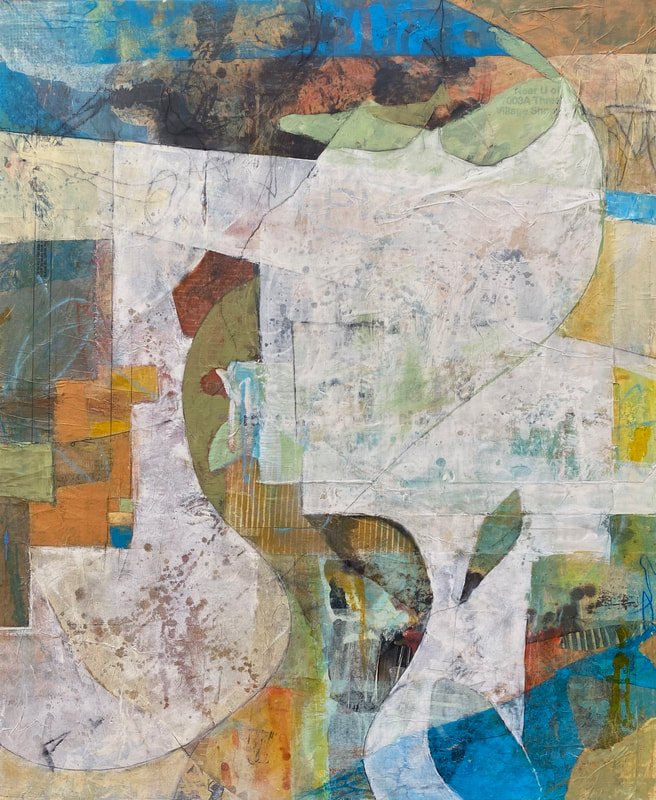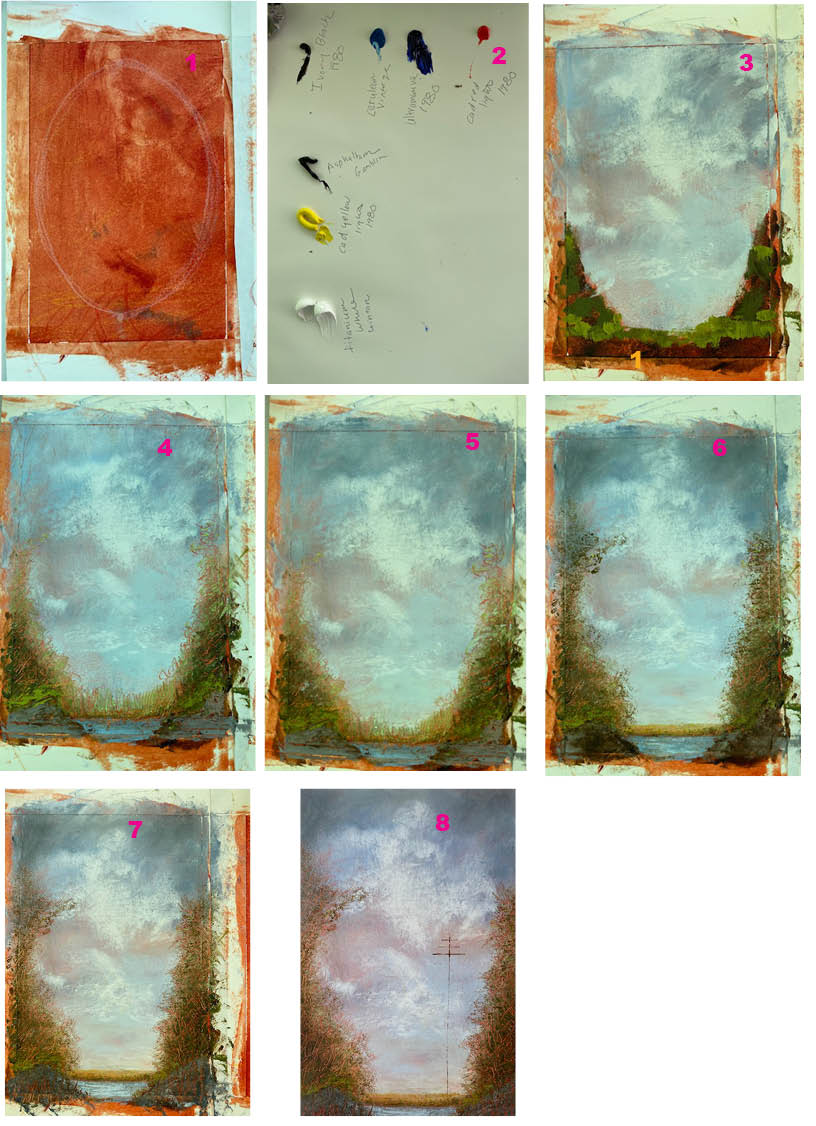|
I teach a mixed media class at the Virginia Museum of Fine Arts Studio School. I suggested a challenge to the class that involved making a random collage and then painting over it. Since then, I have been using this process in my own work. The idea is to put collage elements down without much thought....akin to an automatic drawing process. It is an excellent way to unlock creativity and engage the subconscious. Then, using paint (I usually use oil and cold wax medium) along with mark-making tools and maybe more collage, I find a composition.
Papers for the Collage I use a variety of papers. I like vintage wallpaper, dress patterns, papers I made on a gel plate, stained rice paper, fabric, artist grade tissue paper, packaging, tape, etc. I like a mix of opaque and transparent papers. I am partial to absorbent papers rather than slick/shiny papers because they adhere well. Substrate I am preparing for a show in October 2024 and the pieces will be 36" x 30" so I am building the collages directly onto custom made cradled wood panels. For smaller studies, I like Arches Oil paper and Multi Media Artboard. Glue I use acrylic matte medium to glue the papers down. It does cause some papers to buckle because of the high moisture content but since one of my goals is to build a textured surface that does not bother me at all. If I have a thick or uneven paper, like corrugated cardboard, I will switch to a gel medium for better adhesion. Clear Gesso Because I like oil paint, I seal the entire collage with two coats of clear gesso to protect the paper from the acidity of the oil paint. Getting Started on the Composition I often begin with charcoal to start identifying shapes and structure to the piece. Other favorite mark-making tools are graphite, Caran d'ache neocolor 2 crayons, Prismacolor pencils, and R&F pigment sticks. Initially, I try to keep some of the papers that I really like and build the composition around them. But of course, you have to be open to letting your favorite bits go to get the best painting. Sometimes I end up painting over the entire collage and sometimes I use very little paint. Developing the Painting I keep trying to find shapes and shape relationships. I do not have any idea when I start what the piece is going to look like. I study it, make a move, study again, make another move, etc. until I can't think of anything else I think will enhance the image. Somewhere along the way I try and think about color, value, and all of the visual elements but I am initially more concerned with shapes. Even though I don't have a specific outcome in mind for the painting, I work with a set of intentions, a way of working that I learned during a workshop with Rebecca Crowell. Protecting the Painting Because I use a variety of mark-making tools that are water soluble, when I am finished with the painting I carefully cover the entire piece with a layer of cold wax medium to help ensure it's stabiity. Thank you for visiting my website and I hope this inspires you to give this a try.
0 Comments
1708 Gallery has an annual event called the Monster Drawing Rally. Artists make a piece of art in 1-hour. Here are a few tips and I wish I was disciplined enough to employ most of these all of the time! See a process video!
1. Get all of your materials and tools ready and organized. Drink a large mug of coffee. This is obvious but critical. 2. Use a limited palette. If you select a dark, a light, a warm, and a cool, it is much easier to find your composition. The palette for this oil and cold wax painting is payne's gray, transparent orange oxide, asphaltum, and titanium white. You can always add some other colors at the end. 3. Consider putting your darkest value down first and use it to lead the viewer's eye through the painting. 4. Block in shapes but don't have them touch. After all of the shapes are blocked in, gently begin blending. This will help avoid mud. 5. Consider adding collage. This piece has collage in it. You can move the pieces around before committing to where that particular shape/color is going to go. This is efficient and saves time. 6. Incising and scraping into the cold wax and paint is a quick and easy way to add mark-making. Enjoy making your 1-hour piece! Go! Cold wax medium made it easy to add a small weathered grafitti wall to my painting.
Step 1 Underpainting I did an underpainting using transparent colors. The transparent colors soak into the paper so that if you scratch in later, you can reveal that color. I put Gamblin Asphaltam on the bottom. All of the paint is applied 50/50 oil paint mixed with cold wax. Step 2 Mark Making I was originally going to make the bottom area a beach so I added yellow ochre paint. I covered that with a grey in a medium value. I let the grey set up overnight. The next day, I scratched into the paint with a bamboo skewer and made marks with black and red Marabu art crayons. I learned about these from Pamela Caughey. The resources page on her website an excellent source for discovering new tools. Steps 3 & 4 Texture and Reductive Technique I applied a lighter paint, with a squeegee, using a very light touch to encourage texture. The art crayon bled through beautifully. I added more texture with crumpled tissue paper and more marks with the skewer. I drizzled Gamsol on the wall using the oiler boiler bottle in the picture below. I tried to drizzle in shapes that were suggestive of graffiti. I wiped the gamsol off with a squeegee, revealing the darker grey from the previous layer. The Oiler Boiler set is also featured on Pamela Caughey's resource page. Step 5 Finished Painting I applied a tiny bit of of the light purple pink from the sky to the top of the wall to try and unify it with the rest of the paining. I also added a darker bluer grey under the plants to suggest shadow. That's it! I can't wait to do more of these! When the COVID-19 pandemic got real and the stay at home order was in effect, I started painting these small landscapes. It was a strange response because I had never painted a landscape in my life. I didn't consciously set out to do this, this is just what happened. Maybe it was because we were stuck at home and I longed to be somewhere else. Maybe it was the sense of isolation and the longing to connect with others (which is why I'm writing this now). Time will tell. If you would like to see other paintings in the series, click here. Here's a step by step process. If you have any questions, please feel free to email me. Step 1 I taped off a piece of Arches Oil Paper. I meant to make it 5" x 7" but it is more like 4.5" x 7" which is unfortunate because I will have to custom make a panel for it! If you want to mount your work onto a panel, tape your paper just a little larger than the standard. I made some quick marks with a Stabilo woody pencil and then applied a coat of Gamblin Brown Pink mixed 50/50 with cold wax using a messermeister dough squeegee. Sometimes those pencil marks show through and enrich the painting. They didn't on this one! It is important to use a transparent paint at this stage. It will stain the paper and the color will be revealed when you scratch back in later. This is not the case with an opaque color. I usually let this dry overnight and it is fine. This one dried for a week. Step 2 I set up my palette. Student grade paint works fine when you are mixing it with 50/50 wax. Unless noted, these colors are Gamblin 1980. Titanium White Cadmium Yellow Light Cadmium Red Light Ivory Black Ultramarine Blue Cerulean Blue (a twenty year old tube I inherited) Asphaltam by Gamblin I mixed a few colors from these and then mixed with the wax 50/50. I like to make greens by mixing the black and yellow. Step 3 I quickly blocked in some colors. For the sky, I applied thin layers of a few shades of blue and purple/gray and then used white for the sky. It is best to apply with the squeegee and fuss with it as little as possible.I did not put the paint on very thick. I used asphalam and a couple of shades of green for the land and vegetation. This was done quickly just to add basic structure. Step 4 I started scratching into the paint with a bamboo skewer. My original concept was to have the vines go to the top of the painting but it didn't look good so repaired the sky. I added a pond and some rocks just to make it more interesting and it's a good device to unite the sky color with the rest of the painting. Step 5 I added a darker gray to the top of the painting. I intentionally made the shape unite with the vegetation so the lighter sky is in a circle shape in the center of the painting. I added a greener blue and some white at the horizon. Step 6 I turned the land shape at the horizon into sand, introducing yellow ochre to the palette. I think the straighter line there adds a needed to contrast to all of the scratched out marks. I worked on the rocks in the foreground, putting in a darker value. I crumpled a small piece of tissue paper and dipped it in paint the color of the vegetation. Spread the paint out thinly on your palette before you dip the tissue to aviod getting too much paint. I dabbed the edges of the vegetation. It is an effective method for getting the vegetation color on top of the wet sky without making a muddy mess. Step 7 Here I just refined everything. I touched up the sky. I took my gloves off and used my finger to do this. By the way, the warm color in the sky on the left is the toned Brown Pink ground peeking through. At some point, I gently rubbed this area to make that more pronounced. I added a little paint with similar tones on the right.I added more scratches to the vegetation, using the edge of a palette knife to get thin marks. I added more reflection to the water and added some blue/gray tones to the rocks to tie them in with the colors at the top of the painting. Step 8 I untaped the painting. Sometimes at this stage I'll see something I want to fix but I did not with this one. I added the communication/telephone type pole by thinly spreading a 50/50 paint wax mixture onto my palette and dipping a piece of cardstock into it. That's it! When it is completely dry, in a few weeks I will mount it onto a custom-made (grrr!!) panel with using acrylic gel medium as the glue. |







 RSS Feed
RSS Feed